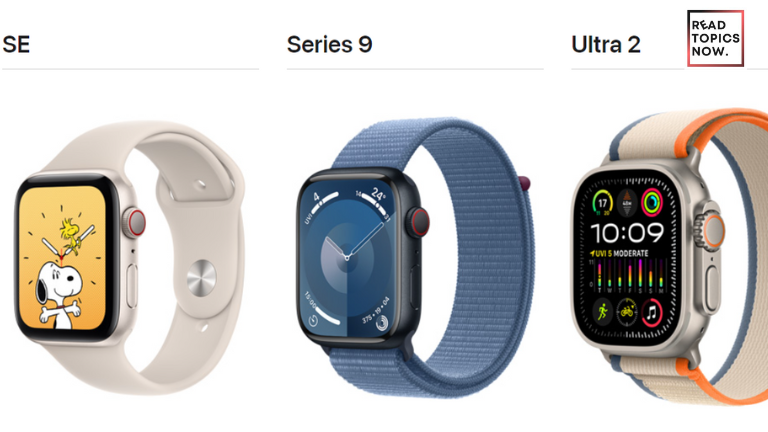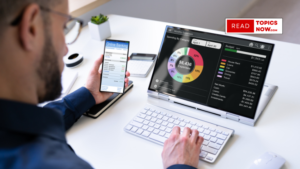
Comparison of Apple Watch SE, Series 10, Ultra 2

Smartwatches have revolutionized personal technology, integrating functionality, health tracking, and convenience into a available on the market, choosing the right smartwatch can be overwhelming. In this detailed comparison, we analyze the top smartwatches available today, highlighting their key features, advantages, and differences. This guide will help you make an informed decision when selecting your next smartwatch.
Comparison Between Apple Watch SE Apple Watch Series 9 Apple Watch Ultra 2
| Feature | Apple Watch SE | Apple Watch Series 9 | Apple Watch Ultra 2 |
|---|---|---|---|
| Case Sizes | 44 mm (aluminium) | 41 mm (aluminium or stainless steel) | 49 mm (titanium) |
| 40 mm (aluminium) | 45 mm (aluminium or stainless steel) | ||
| Carbon-neutral Combinations | Available | Available | Available |
| Display | Retina display, Up to 1,000 nits | Always-On Retina display, Up to 2,000 nits | Always-On Retina display, Up to 3,000 nits |
| Chip | S8 SiP | S9 SiP | S9 SiP |
| Double Tap Gesture | Not available | Available | Available |
| Siri | Standard | Faster on-device Siri | Faster on-device Siri |
| Find iPhone | Standard | Precision Finding for iPhone2 | Precision Finding for iPhone2 |
| Blood Oxygen App | Not available | Available | Available |
| ECG App | Not available | Available | Available |
| High and Low Heart Rate Notifications | Available | Available | Available |
| Irregular Rhythm Notifications | Available | Available | Available |
| Low Cardio Fitness Notifications | Available | Available | Available |
| Temperature Sensing | Not available | Available | Available |
| Cycle Tracking | Available | Available with retrospective ovulation estimates | Available with retrospective ovulation estimates |
| Emergency SOS | Available | Available | Available |
| International Emergency Calling | Available | Available | Available |
| Fall Detection and Crash Detection | Available | Available | Available |
| Siren | Not available | Not available | Available |
| Water Resistance | Water resistant | Water resistant | Water resistant |
| Swimproof | Swimproof | Swimproof | Swimproof |
| High-Speed Water Sports | Not available | Not available | Available |
| Depth Rating | Not available | Not available | Recreational dive to 40 m |
| GPS | GPS | GPS | Precision dual-frequency GPS |
| Cellular Connectivity | Available | Available | Available |
| Supports Apple Watch for Your Kids | Available (GPS + Cellular models) | Available (GPS + Cellular models) | Available (GPS + Cellular models) |
| Battery Life | Up to 18 hours | Up to 18 hours | Up to 36 hours |
| Low Power Mode | Up to 36 hours in Low Power Mode | Up to 36 hours in Low Power Mode | Up to 72 hours in Low Power Mode |
| Fast Charging | Not available | Fast charging | Fast charging |
Key Features of Leading Smartwatches
1. Design and Build Quality
When it comes to smartwatches, design and build quality are crucial factors to consider. The right smartwatch should not only feel comfortable on your wrist but also match your style preferences.
- Materials: Most premium smartwatches, like the Apple Watch Series, use aluminum, stainless steel, or titanium, offering durability and lightweight wear. Others, such as the Samsung Galaxy Watch, offer a blend of high-quality materials that ensure longevity without sacrificing style.
- Customization Options: Look for watches that allow customization with interchangeable bands and different watch faces. Apple and Garmin, for example, offer a wide variety of bands to personalize your watch for formal or casual occasions.
2. Display Quality
The display quality directly influences the overall user experience, especially for visibility in various lighting conditions and touch responsiveness.
- Display Technology: OLED and AMOLED displays, like those found in the Apple Watch Series 9 and Samsung Galaxy Watch 6, offer vibrant colors and deeper blacks compared to LCD displays. The sharpness and clarity of these displays ensure easy readability, even under direct sunlight.
- Always-On Display: Many smartwatches, including recent Apple and Garmin models, feature an always-on display, allowing users to check the time and notifications without activating the screen.
3. Health and Fitness Tracking
Health and fitness tracking have become essential features in modern smartwatches. Leading models come equipped with advanced sensors to monitor various aspects of health and fitness.
- Heart Rate Monitoring: Continuous heart rate monitoring has become a standard feature. Apple, Fitbit, and Garmin watches offer accurate heart rate tracking, providing insights into resting and active heart rates, helping users maintain optimal cardiovascular health.
- ECG Functionality: For those looking for medical-grade health monitoring, Apple and Fitbit smartwatches offer built-in ECG sensors. This feature can detect irregular heartbeats and potentially help identify early signs of heart conditions.
- SpO2 Monitoring: Measuring blood oxygen saturation is vital for users focused on endurance sports or concerned with respiratory health. Many high-end models, such as the Apple Watch Series 9 and Garmin Fenix 7, include this sensor.
- Sleep Tracking: Most smartwatches offer detailed sleep analytics, breaking down sleep stages (light, deep, and REM) to provide insights into sleep quality. Fitbit and Garmin are particularly known for their advanced sleep tracking algorithms.
4. Battery Life and Charging
Battery life varies significantly among smartwatches, depending on features, display type, and usage patterns.
- Long Battery Life: Watches like the Garmin Fenix 7 and Fitbit Sense offer multi-day battery life, which can last up to a week or more with standard use. This is ideal for those who don’t want to worry about charging daily.
- Fast Charging: Apple and Samsung watches feature fast-charging capabilities, reducing the time spent tethered to the charging cable. With just a few minutes of charging, you can extend usage significantly.
5. Connectivity and Compatibility
Seamless connectivity with smartphones is essential for a good smartwatch experience.
- Operating System Compatibility: Apple Watch models work best with iPhones, while Samsung and other Android-compatible smartwatches offer broader compatibility. It’s important to choose a smartwatch that integrates smoothly with your existing devices.
- LTE and Cellular Options: For those who prefer to leave their phone behind, many smartwatches offer LTE capabilities, allowing you to make calls, send messages, and stream music without being tethered to your phone.
Performance Comparison: Apple Watch vs. Competitors
1. Apple Watch Series 9
The Apple Watch Series 9 is known for its premium design, top-tier health features, and seamless integration with iPhones.
- WatchOS: With WatchOS, the Series 9 delivers one of the most user-friendly and responsive experiences. Its ecosystem, app support, and fitness tracking accuracy make it a top contender.
- Advanced Sensors: Equipped with ECG, SpO2, and skin temperature sensors, the Apple Watch Series 9 excels in health tracking.
- Battery: The battery life, while not the longest on the market, lasts around 18 hours in normal use. Fast charging compensates for this limitation.
2. Samsung Galaxy Watch 6
The Samsung Galaxy Watch 6 is a strong competitor with a versatile feature set that caters to both Android and iPhone users.
- Wear OS: Powered by Wear OS, it offers a smooth interface, access to Google Play apps, and reliable fitness tracking.
- Display: Its AMOLED display is one of the best in the market, offering sharp visuals and smooth touch responsiveness.
- Battery Life: With moderate usage, it lasts up to 2 days on a single charge.
3. Garmin Fenix 7
Garmin is known for rugged, outdoor-focused smartwatches, and the Fenix 7 exemplifies this perfectly.
- Durability: Built for outdoor adventurers, the Fenix 7 is water-resistant up to 100 meters and offers military-grade durability.
- Battery: Garmin Fenix watches provide excellent battery life, often lasting over a week, even with GPS tracking and other features active.
- Advanced Metrics: Garmin excels in fitness tracking, especially for athletes, with advanced metrics like VO2 max, recovery time, and performance conditions.
4. Fitbit Sense
Fitbit continues to dominate the health and wellness sector with its Fitbit Sense model.
- Stress Management: Fitbit Sense stands out with its focus on stress management, offering an electrodermal activity (EDA) sensor for tracking stress responses.
- Health Monitoring: It provides comprehensive health monitoring, including heart rate variability (HRV), SpO2, and ECG capabilities.
- Battery: The battery life on Fitbit Sense lasts up to 6 days, making it a great option for users who value longevity.
Conclusion: Which Smartwatch is Best for You?
Choosing the right smartwatch depends on your lifestyle, priorities, and compatibility needs. For iPhone users looking for seamless integration and advanced health features, the Apple Watch Series 9 remains a top choice. However, if you seek long battery life and a rugged design, the Garmin Fenix 7 offers unparalleled durability and fitness tracking. For Android users, the Samsung Galaxy Watch 6 provides the best balance of features and performance, while the Fitbit Sense is ideal for those focused on health and wellness.
By carefully evaluating these key features, you can confidently select the smartwatch that best suits your needs, ensuring that your investment in wearable technology enhances your everyday life.
Get Curated Post Updates!
Sign up for my newsletter to see new photos, tips, and blog posts.

I’m Prateek Katiyar, a passionate content writer with a knack for exploring diverse subjects. From tech trends to travel tips, and everything in between, I thrive on crafting engaging and informative content that captivates audiences.





